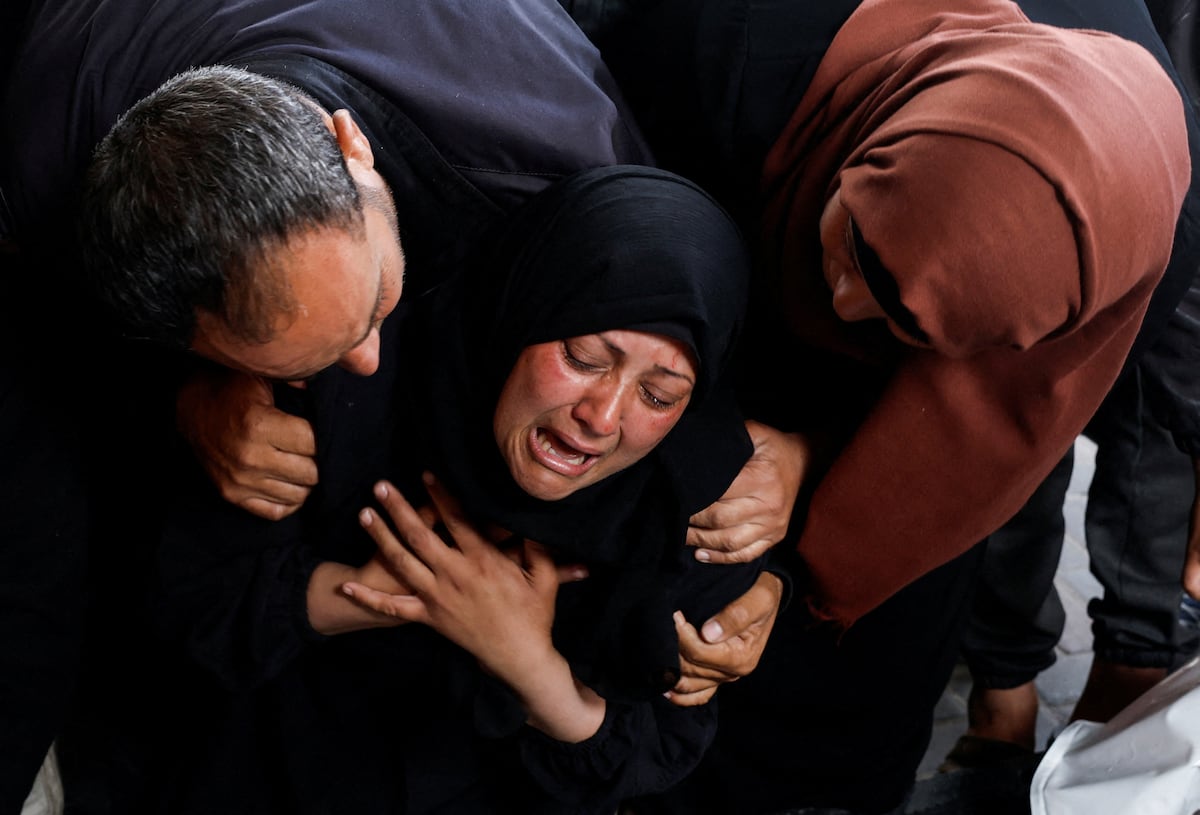The leaflets are printed. The Israeli army planned to launch them this week on Rafah to order more than half of Gaza's 2.3 million inhabitants to abandon their last precarious refuge, according to Israeli public radio. Shortly before, the Ministry of Defense had published a public tender to acquire 40,000 tents that could accommodate 480,000 people, 12 in each one. This is where the unprecedented Iranian attack against Israel came last Saturday, and the Prime Minister, Benjamin Netanyahu, backed down, so as not to bother the United States, the ally that had just shot down most of the drones and missiles launched by Tehran and who considers it “a big mistake” to invade Rafah.
Since announcing it almost two months ago, Netanyahu has used the invasion of Rafah as a decoy, as a tool of psychological warfare – “it already has a date,” he warned last week – as pressure on Hamas to soften its stance in the negotiations for a ceasefire and exchange of prisoners for hostages, as candy for his ultranationalist partners and, above all, as the last stretch of the “total victory” that he sees “within reach.”
The sword of Damocles has dropped a few centimeters in recent days. The army has just called up thousands of reservists for “operational activities on the Gaza front” and Defense Minister Yoav Gallant met this Monday to “debate a series of measures in preparation for operations in Rafah, with emphasis on the evacuation of civilians and the expansion of activities related to the delivery of food and medical equipment.” He could now become part of the promised response to Tehran, which he blames for the surprise attack carried out by Hamas last October that sparked the war. 44% of Israelis support invading Rafah, even if it would represent a crisis in relations with the United States, compared to 25% who oppose and 31% of undecided people, according to a poll released this Monday by the Hebrew University of Jerusalem.
Christopher Lockyear is secretary general of Doctors Without Borders and spoke before the United Nations Security Council in February to denounce that the inhabitants of Rafah were already living “in fear of invasion” and to call for an immediate ceasefire. A month later he went there for four days to see the projects in Gaza and the situation on the ground. He came back with a conclusion: “A ground offensive in Rafah would be absolutely horrible. A butchery". He tells it just after returning from Gaza, in an interview with this newspaper at the NGO's headquarters in the Palestinian neighborhood of Shuafat, in East Jerusalem, carried out before the Iranian attack.
Lockyear insists that the problem is not how to manage an offensive on the ground with troops and armor in such a crowded place, but the idea itself: “I don't see any scenario surrounding the ground invasion of Rafah that is not catastrophic.” . Due to the prevailing chaos and population movements, it is not clear how many people are concentrated there, trying to survive. The United Nations estimates them at between 1.4 and 1.5 million. They are mostly displaced from other parts of Gaza, even several times. “All the roads are lined with tents and makeshift shelters. A trip that used to last 10 minutes now lasts an hour,” she recalls.
Join EL PAÍS to follow all the news and read without limits.
Subscribe
Rafah is in the south, on the border with Egypt. It is exactly where the Israeli army gave orders to go to the more than one million inhabitants of the north, at the beginning of the war. The buildings in which they lived are today largely rubble or uninhabitable, to which is added the ravages of the humanitarian crisis, despite the entry of more aid in recent days, indicated this Monday by the United States, after forcing Israel to soften his use of hunger as a weapon of war in the wake of international outrage over the murder of seven humanitarian workers from chef José Andrés' NGO, World Central Kitchen. That is to say, more punished people have less to return to than when they forcibly left their homes for the first time five months ago.
"No possibility"
Lockyear, a 44-year-old Briton, sees it as practically impossible to displace all the Palestinians in Rafah. And, even if he were, he clarifies, it would be at the cost of his health. “I spoke to displaced people two, three, four times in the last few months. One of the possibilities being talked about is taking people to a beach, which is very narrow. No running water, no hygienic conditions, no toilets… It is completely absurd to think that you can move 1.5 million people safely without seriously damaging their health. I can't see any feasible possibilities,” he notes.
Hospitals couldn't stand it either, already beyond their capacities. Lockyear visited several. He arrived at one of them – Al Aqsa, in Deir al Balah, in the center of the Strip – after a night of intense bombing in the area. He says that he did not dare to count how many bodies there were in the morgue located inside the compound and that a center was found surrounded by displaced people and with the corridors "full on both sides of people waiting for their wounds to be dressed." “It was hot, it was dark and I was avoiding stepping on people because of the high density of patients,” he says.
That area of Gaza already suffered from health problems before the war. Now, he remembers, in the pediatric department they faced such dramatic dilemmas as deciding whether to allocate the beds to those injured by the bombings or to cases of malnutrition, because there was not enough for everyone.
_

